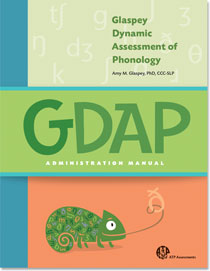
Author(s): Amy Glaspey, PhD, CCC-SLP
The GDAP matrix can be administered via paper and pencil, or easily through the ATP Online interface.
The GDAP has 49 items, including 2 multisyllabic words, 22 initial phonemes, 21 final phonemes, 3 initial blends, and 1 final blend. Sound classes represented in the GDAP include:
|
|
Each item is tested in up to three speech environments using vibrant, child-friendly images:
The GDAP was normed on a representative sample of 880 children ages 3.0 through 10.11.
Administration and Scoring
The GDAP is designed to be administered flexibly to get a comprehensive assessment of a child’s speech production or to document a child’s response to therapy for individual phonemes or sound classes. The clinician may administer the entire evaluation to a preschool-aged child with multiple errors; or the clinician may administer only specific test items as needed, such as the Liquid test items to an older elementary child with /l/ and /r/ errors.
Each target can be quickly administered in 2-3 minutes. The Phonemic Inventory which can be administered prior to the GDAP to document the phonemes already in the child’s repertoire, thereby reducing testing time.
Criterion-based scores are provided for each item and can be further analyzed using frequency and age of mastery tables. Sound Classes are reported as scaled scores and percentile ranks, and the Overall score is reported as a standard score and percentile rank. Standard scores are also available for Initial and Final Position Phonemes. Significant changes in score can be documented using the Reliable Change Index.
Reliability and Validity
The TNL is an easy-to-administer tool to assess how well children use their knowledge of language components as they engage in functional discourse.
Arizona-4 provides a comprehensive assessment of articulation in children from 18 months to 21 years.
The TOSR assesses breadth (the number of lexical entries one has) and depth (the extent of semantic representation for each known word) of vocabulary knowledge without taxing expressive language skills, providing an important new resource for individuals assessing children with possible language and literacy deficits.
The TELD-4 is a highly reliable and valid measure of spoken language in children ages 3 years 0 months through 7 years 11 months.
The CTOPP-2 assesses reading-related phonological processing skills. The test has been renormed on a nationally stratified sample of 1,900 individuals, and the age range extended downward by adding items to eliminate floor effects. The ceiling has also been extended.